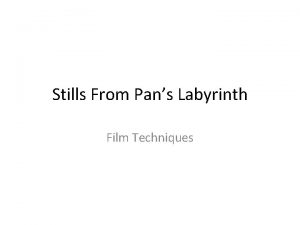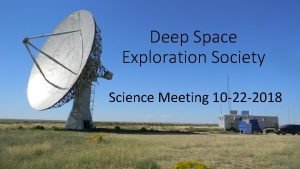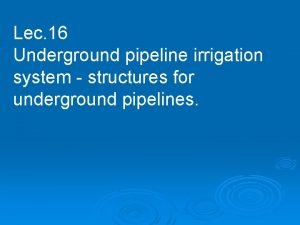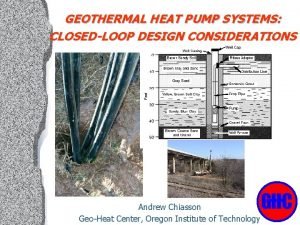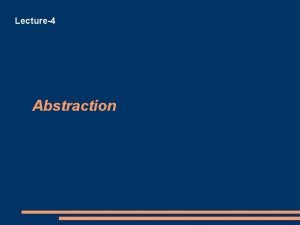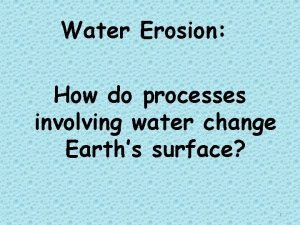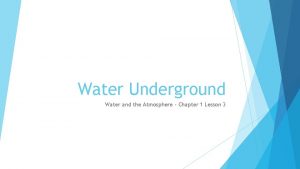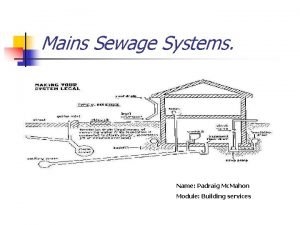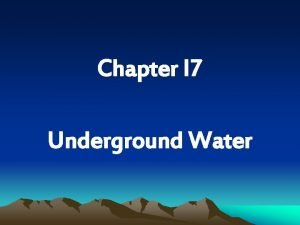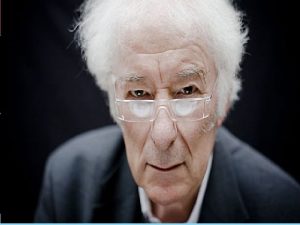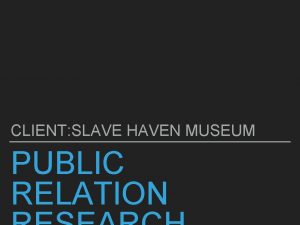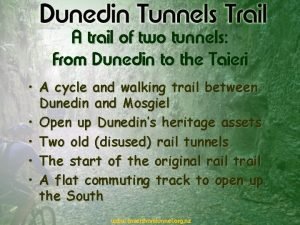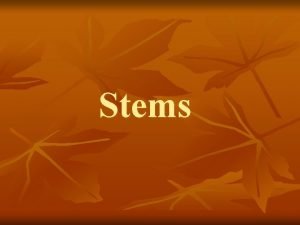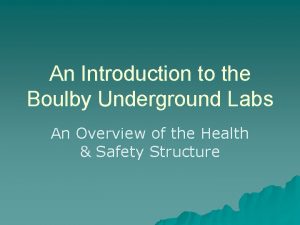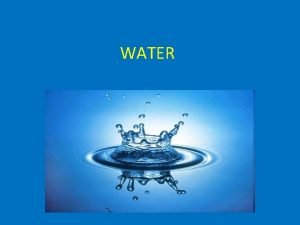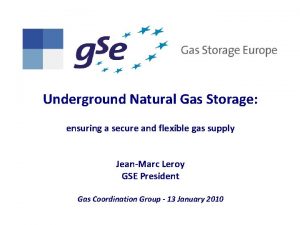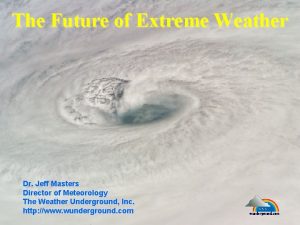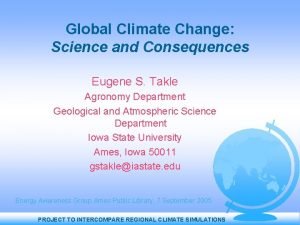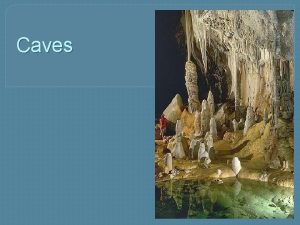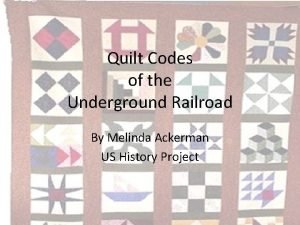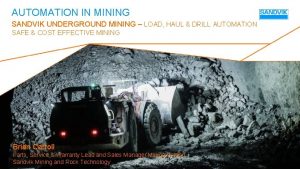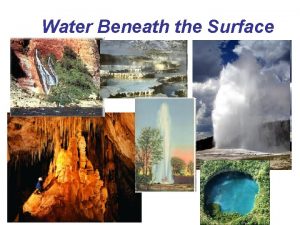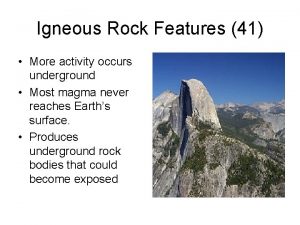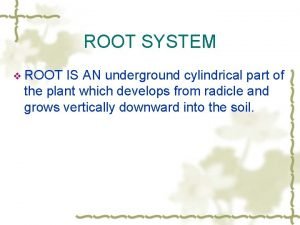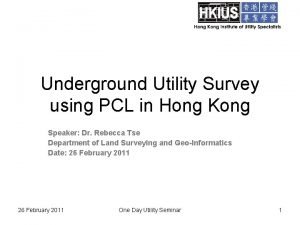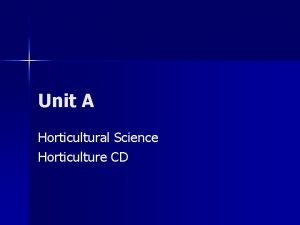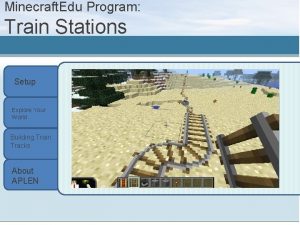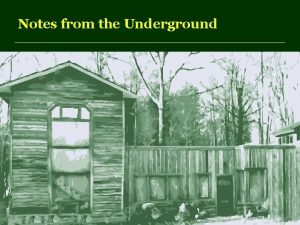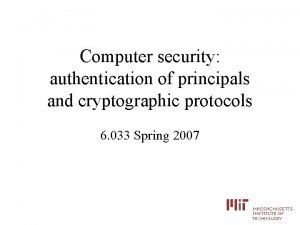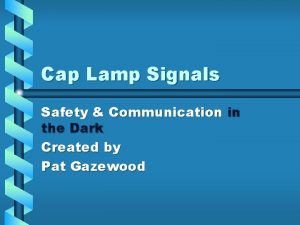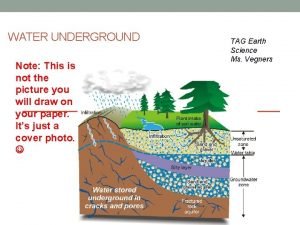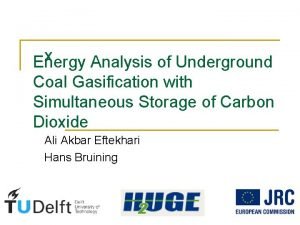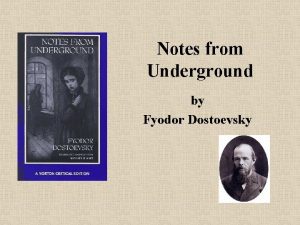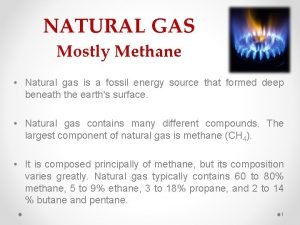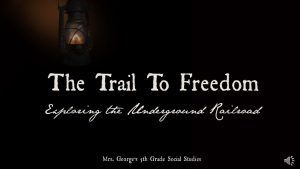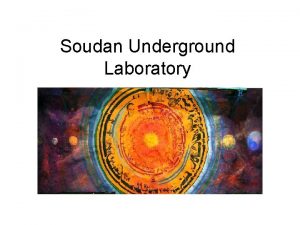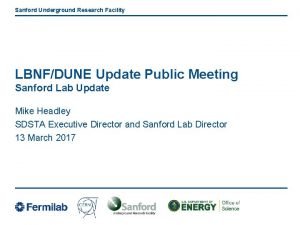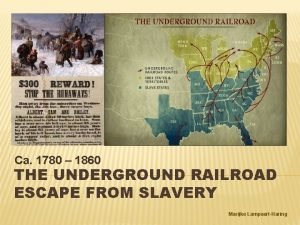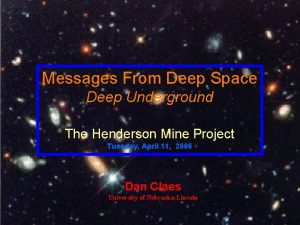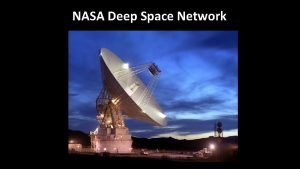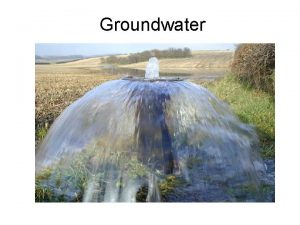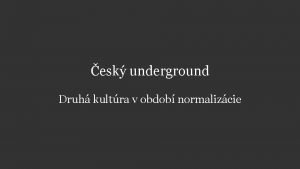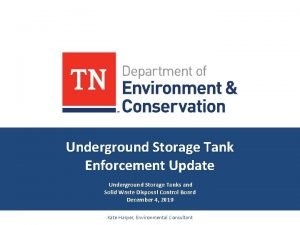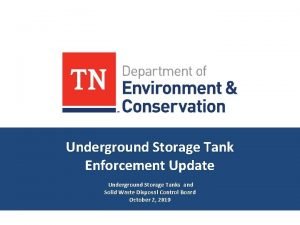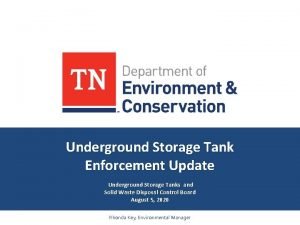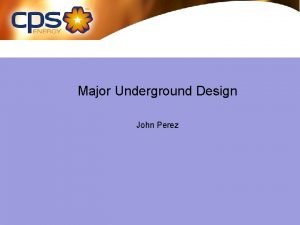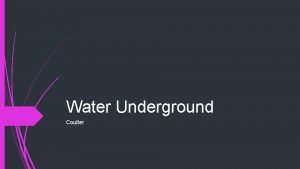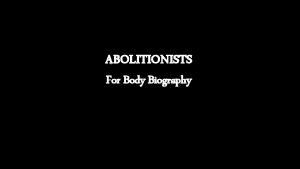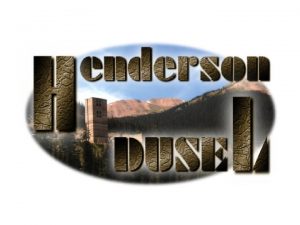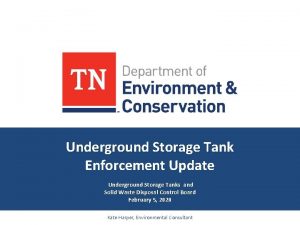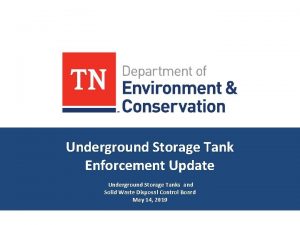Messages From Deep Space Deep Underground The Henderson







































































- Slides: 71

Messages From Deep Space Deep Underground The Henderson Mine Project Thursday, December 15, 2005 Dan Claes University of Nebraska-Lincoln

Henri Becquerel (1852 -1908) received the 1903 Nobel Prize in Physics for the discovery of natural radioactivity. Wrapped photographic plate showed clear silhouettes, when developed, of the uranium salt samples stored atop it. 1896 While studying the photographic images of various fluorescent & phosphorescent materials, Becquerel finds potassium-uranyl sulfate spontaneously emits radiation capable of penetrating thick opaque black paper aluminum plates copper plates Exhibited by all known compounds of uranium (phosphorescent or not) and metallic uranium itself.

• In ordinary photographic applications light produces spots of submicroscopic silver grains • a fast charged particle can leave a trail of individual Ag grains • 1/1000 mm (1/25000 in) diameter grains • plates coated with thick emulsions (gelatins carrying silver bromide crystals) clearly trace the tracks of charged particles

1898 Marie Curie discovers thorium (90 Th) Together Pierre and Marie Curie discover polonium (84 Po) and radium (88 Ra) 1899 Ernest Rutherford identifies 2 distinct kinds of rays emitted by uranium - highly ionizing, but completely absorbed by 0. 006 cm aluminum foil or a few cm of air - less ionizing, but penetrate many meters of air or up to a cm of aluminum. 1900 P. Villard finds in addition to rays, radium emits - the least ionizing, but capable of penetrating many cm of lead, several feet of concrete


B-field points into page 1900 -01 Studying the deflection of these rays in magnetic fields, Becquerel and the Curies establish rays to be charged particles

1900 -01 Using the procedure developed by J. J. Thomson in 1887 Becquerel determined the ratio of charge q to mass m for : q/m = 1. 76× 1011 coulombs/kilogram identical to the electron! : q/m = 4. 8× 107 coulombs/kilogram 4000 times smaller!

1911 -12 Austrian physicist Victor Hess, of the Vienna University, and 2 assistants, carried Wulf ionization chambers up in a series of hydrogen balloon flights. • taking ~hour long readings at several altitudes • both ascending and descending • radiation more intense above 150 meters than at sea level • intensity doubled between 1000 m to 4000 m • increased continuously through 5000 meters Dubbed this “high” level radiation Höhenstrahlung Hess lands following a historic 5, 300 meter flight. August 7, 1912 National Geographic photograph

1937 Marietta Blau and Herta Wambacher report “stars” of tracks resulting from cosmic ray collisions with nuclei within the emulsion 50 mm Cosmic ray strikes a nucleus within a layer of photographic emulsion

primary proton 1936 Millikan’s group shows at earth’s surface cosmic ray showers are dominated by electrons, gammas, and X-particles capable of penetrating deep underground (to lake bottom and deep tunnel experiments) and yielding isolated single cloud chamber tracks

The Cosmic Ray Energy Spectrum Cosmic Ray Flux (1 particle per m 2 -sec) (1 particle per m 2 -year) (1 particle per km 2 -year) Energy (e. V)

Two possible sources of the highest energy cosmic rays Colliding galaxies Active galactic nucleus

Before the explosion: Mass, M After the explosion: vo = 0 m 1 m 2 v 1 v 2 p=0 pi = 0 = pf = pgas + procket pgas = – procket

A cannon rests on a railroad flatcar with a total mass of 1000 kg. When a 10 kg cannon ball is fired at a speed of 50 m/sec, as shown, what is the speed of the flatcar? A) B) C) D) 0 ½ 1 20 m/s to the right m/s to the left m/s to the right

For these two vehicles to be stopped dead in their tracks by a collision at this intersection A) B) C) D) They must have equal mass They must have equal speed both A snd B is IMPOSSIBLE

Car A has a 650 kg mass and is traveling east at 10 m/sec. Car B has a 500 kg mass and is traveling north 20 m/sec. The two cars collide, and lock bumpers. Neglecting friction which arrow best represents the direction the combined wreck travels? A B C 650 kg 10 m/sec 500 kg 20 m/sec

? A bomb at rest explodes into four fragments. The momentum vectors for three of the fragments are shown. Which arrow below best represents the momentum vector of the fourth fragment?


-decay E = -decay 2 mc

Some Alpha Decay Energies and Half-lives Isotope 232 Th 238 U 230 Th 238 Pu 230 U 220 Rn 222 Ac 216 Rn 212 Po 216 Rn KE (Me. V) 4. 01 4. 19 4. 69 5. 50 5. 89 6. 29 7. 01 8. 05 8. 78 t 1/2 1. 4 1010 y 4. 5 109 y 8. 0 104 y 88 years 20. 8 days 56 seconds 5 seconds 45. 0 sec 0. 30 sec 0. 10 sec l(sec-1) 1. 6 10 -18 4. 9 10 -18 2. 8 10 -13 2. 5 10 -10 3. 9 10 -7 1. 2 10 -2 0. 14 1. 5 104 2. 3 106 6. 9 106

1930 Series of studies of nuclear beta decay, e. g. , Potassium goes to calcium Copper goes to zinc Boron goes to carbon Tritium goes to helium 20 Ca 40 64 64 29 Cu 30 Zn 12 C 12 B 5 6 3 He 3 1 H 2 19 K 40 Potassium nucleus Before decay: After decay: A B

1932 Once the neutron was discovered, included the more fundamental n p+e For simple 2 -body decay, conservation of energy and momentum demand both the recoil of the nucleus and energy of the emitted electron be fixed (by the energy released through the loss of mass) to a single precise value. Ee = (m. A 2 - m. B 2 + me 2)c 2/2 m. A but this only seems to match the maximum value observed on a spectrum of beta ray energies!

No. of counts per unit energy range 0 5 10 15 Electron kinetic energy in Ke. V 20 The beta decay spectrum of tritium ( H He). Source: G. M. Lewis, Neutrinos (London: Wykeham, 1970), p. 30)

Intensity Energy spectrum of beta decay electrons from 210 Bi Kinetic energy, Me. V

-decay spectrum for neutrons Electron kinetic energy in Me. V

1932 charge mass spin n p + e + neutrino ? ? ? 0 939. 56563 Me. V ½ +1 -1 938. 27231 0. 51099906 Me. V ½ ? 0 <0. 78232 ? Me. V ½ ? ½ the Fermi-Kurie plot. The Fermi-Kurie plot looks for any gap between the observed spectrum and the calculated Tmax neutrino mass < 5. 1 e. V < me /100000 0

Niels Bohr hypothesized some new quantum mechanical restriction on the principle of energy conservation, but Pauli couldn’t buy that: Wolfgang Pauli 1900 -1958

Dear Radioactive Ladies and Gentlemen, as the bearer of these lines, to whom I graciously ask you to listen, will explain to you in more detail, how because of the "wrong" statistics of the N and Li 6 nuclei and the continuous beta spectrum, I have hit upon a desperate remedy to save the "exchange theorem" of statistics and the law of conservation of energy. Namely, the possibility that there could exist in the nuclei electrically neutral particles, that I wish to call neutrons, which have spin 1/2 and obey the exclusion principle and which further differ from light quanta in that they do not travel with the velocity of light. The mass of the neutrons should be of the same order of magnitude as the electron mass and in any event not larger than 0. 01 proton masses. The continuous beta spectrum would then become understandable by the assumption that in beta decay a neutron is emitted in addition to the electron such that the sum of the energies of the neutron and the electron is constant. . . I agree that my remedy could seem incredible because one should have seen those neutrons much earlier if they really exist. But only the one who dare can win and the difficult situation, due to the continuous structure of the beta spectrum, is lighted by a remark of my honoured predecessor, Mr Debye, who told me recently in Bruxelles: "Oh, It's well better not to think to this at all, like new taxes". From now on, every solution to the issue must be discussed. Thus, dear radioactive people, look and judge. Unfortunately, I cannot appear in Tubingen personally since I am indispensable here in Zurich because of a ball on the night of 6/7 December. With my best regards to you, and also to Mr Back. Your humble servant. W. Pauli, December 1930

"I have done a terrible thing. I have postulated a particle that cannot be detected. "

1953, 1956, 1959 Savannah River (1000 -MWatt) Nuclear Reactor in South Carolina looked for the inverse of the process: n p + e- + neutrino p + neutrino n + e+ Cowan & Reines with estimate flux of 5 1013 neutrinos/cm 2 -sec observed 2 -3 p + neutrino events/hour We have n + neutrino p + enever observed What does that tell us?

The Nuclear pp cycle producing energy in the sun 6 protons 4 He + 6 g + 2 e + 2 p Begins with the reaction 26. 7 Me. V 0. 26 Me. V neutrinos

500 trillion solar neutrinos every second!

Under the influence of a magnetic field + p+ + energy always predictably fixed by E simple 2 -body decay! + + + neutrino? charge spin +1 0 +1 ½ 0? ? ½

n p + e + neutrino? + + + neutrino? Then p - e- + neutrino? ? e As in the case of decaying radioactive isotopes, the electrons’s energy varied, with a maximum cutoff (whose value was the 2 -body prediction) 3 body decay! e 2 neutrinos

1962 Lederman, Schwartz, Steinberger Brookhaven National Laboratory using a as a source of antineutrinos and a 44 -foot thick stack of steel (from a dismantled warship hull) to shield everything but the ’s found 29 instances of + p + + n but none of + p e+ + n 1988 Nobel Prize in Physics "for the neutrino beam method and the demonstration of the doublet structure of the leptons through the discovery of the mu neutrino"

Homestake Mine Experiment 1967 • built at Brookhaven labs • 615 tons of tetrachloroethylene • Neutrino interaction 37 Cl 37 Ar (radioactive isotope, ½ = 35 days) Chemically extracting the 37 Ar, its radioactivity gives the number of neutrino interactions in the vat (thus the solar neutrino flux). Results: Collected data 1969 -1993 (24 years!!) gives a mean of 2. 5± 0. 2 SNU while theory predicts 8 SNU (1 SNU = 1 neutrino interaction per second for 10 E+36 target atoms) This is a neutrino deficit of 69%.

Solar models predict the spectrum and flux of solar neutrinos reaching the earth The energy spectrum of solar neutrinos predicted by the BP 04 solar model. For continuum sources, the neutrino fluxes are given in number of neutrinos cm-2 s-1 Me. V-1 at the Earth's surface. For line sources, the units are number of neutrinos cm-2 s-1. Total theoretical uncertainties are shown for each source. The difficult-to-detect CNO neutrino fluxes have been omitted in this plot.

The Solar Neutrino Problem The rate of detection of solar e’s from is 3 smaller than expected!

Is the sun’s core cooler than we thought? 6% Is it a different age than we had assumed? 1998 New and extraordinarily precise measurements of “solar sound speeds” • small oscillations in spectral line strengths • studied by solar seismologists • due to pressure waves traversing the solar volume confirm the predictions of internal temperature and pressure by standard solar models to with 0. 1%


Atmospheric Neutrino Detection Each pion decays by → + and each muon decays by → e + (all Ks decaying rapidly into s) e all showers start with s and Kaons Note: at sea level e e e e N 2 = N e

Given the time dilation of muon lifetimes (and the probabilistic nature of their decays) we can still calculate/simulate the ratio we expect to observe at the ground, and compare: One detector measures this significantly more accurately than any other Super. Kamiokande They find Rsub-Ge. V = 0. 63 0. 06 Rmulti-Ge. V = 0. 65 0. 09

“Evidence for an oscillatory signature in atmospheric neutrino oscillation” Y. Ashie, et. al. (the Super-Kamiokande Collaboration) Phys. Rev. Lett. 93, 101801 (2004).

Underground Neutrino Observatory The proposed next-generation underground water Čerenkov detector to probe physics beyond the sensitivity of the highly successful Super-Kamiokande detector in Japan

The Super. K detector is a water Čerenkov detector 40 m tall 40 m diameter stainless steel cylinder containing 50, 000 metric tons of ultra pure water The detector is located 1 kilometer below Mt. Ikenoyama inside the Kamioka zinc mine.

The main sensitive region is 36 m high, 34 m in dia viewed by 11, 146 inward facing Hamamatsu photomultiplier tubes surrounding 32. 5 ktons of water

Underground Neutrino Observatory • 650 kilotons • active volume: 440 kilotons 20 times larger than Super-Kamiokande $500 M major components: photomultiplier tubes, excavation, water purification system. The optimal detector depth to perform the full proposed scientific program of UNO 4000 meters-water-equivalent or deeper

DUSEL: A National Science Foundation initiative to establish a national underground laboratory for research in physics, Earth and environmental sciences, civil and Mining engineering, and the Biosciences. Soudan Mine Soudan, MN Icicle Creek Cascades, WA Homestake Mine Lead, SD Mount San Jacinto, CA Henderson Mine Empire, CO Kimballton Mine Giles Co. , West VA WIPP Carlsbad, NM “The science cuts across disciplines and Directorates (ENG, GEO, and MPS) and provides opportunities for transformational breakthroughs and to educate the scientists & engineers of the 21 stcentury” Michael S. Turner, Assistant Director for Mathematics and Physical Science Division (NSF)

Geo-outposts will explore below the ore body! Lt Blue proposed access ramps Green exploratory drill holes Dk Blue – Geo research areas Red – Added geo access l. Ore Geology, Magmatic. Hydrothermal Processes, and Petrogeneis l. Hydrogeology l. Coupled Processes l. Geophysical imaging l. Stress in the earth


What do we know so far? New, unusual microbes and sequences indicative of ancestral linkages, less evolved sequences (early life? ), biomedical and biotech applications image courtesy of Gordon Southam Novel bacterial lineages that appear unique to the South African deepsubsurface: SASFi. G-6 South Africa Subsurface Firmicutes SASFi. G-5 Groups (SASFi. G) SASFi. G-4 SASFi. G-3 * strictly anaerobic; iron-reducer optimal growth temperature = 60 o. C virgin rock temp = ~ 45 o. C * SASFi. G-7 SASFi. G-9 SASFi. G-8 SASFi. G-1 *SASFi. G-9 (isolated) Detected within a water-bearing dyke/fracture at 3. 2 Km depth. 1 m SASFi. G-2

Major Questions in Geomicrobiology How deeply does life extend into the Earth? What are the lower limits of life in the biosphere? l Temperature, Pressure, Nutrients/ energy Cells/ml or Cells/g 1 1 1010 0 7 7 3 3 105105 1010 1 1 Depth (km) l 2 2 3 3 4 5 5 6 ? S. African data + Onstott et al. 1998 Fig. 2 of Earthlab report

Henderson DUSEL Biology Questions • What’s down there? Bacteria? Archaea? Eukaryotes? Viruses? • Survey the biodiversity: “what” is “where”? • What limits life? Depth, temperature, p. H, substrate, energy source? • Genomics and proteomics—search for new genes, proteins (to include functional gene analyses, geochemical analyses, and stableisotope analyses to identify sources of energy) • How do microbes harness energy (interaction of water and rock? ) • Isotopic analyses to infer chemical or biological origin • What are the genetic and physiological adaptations to such “life in the slow lane”? • Are the most ancient lineages of life found deep below the surface? • Did life 1 st evolve deep underground, and spread to the surface?

Geobiology Opportunities and Facilities at Henderson Near Term: S 2 project -- exploratory borehole(s) Long Term: 20 -30 life of DUSEL Surface lab and freezer storage Central campus Dedicated microbiology lab Deep Exploration Station (DES) for drilling to great depth Outpost sites for geomicrobiology exploration and experiments

Sampling minerals and bio-film surrounding a flowing borehole, December 2005

SALTA: Snowmass Area Large Time-Coincidence Array Empire • Aspen High School, Aspen, CO • Basalt High School, Basalt, CO • Roaring Fork Valley High School, Carbondale, CO • Lake County High School, Leadville, CO The highest-elevation school in U. S. -- 10, 152 feet above sea level • Clear Creek High School, Empire, CO

SALTA Workshop, July 2001, Snowmass, CO Making detectors light-tight Polishing scintillator edges outside Conference Center mass phototube gluing

CROP Summer Workshops http: //crop/unl. edu/

CROP article in Lincoln Journal Star, 7 August 2003

The Chicago Air Shower Array located in the Utah Desert: 1089 stations, 15 m spacing covering 0. 23 square km recycling retired detectors from the Chicago Air Shower Array 2 ft x ½ inch PMMA (polymethyl methacrylate) doped with a scintillating fluor Read out by 10 stage EMI 9256 photomultiplier tube

The CROP team at Chicago Air Shower Array (CASA) site U. S. Army Photo September 30, 1999

2000 scintillator panels, 2000 PMTs, 500 low and power supplies at UNL CASA detectors’ new home at the University of Nebraska

Aspen Center for Physics Education & Outreach Workshop July 6 -8, 2004 SALTA schools take over the library, setting up cosmic ray telescopes, for training in the new DAQcard that will be used in all their data-taking.

Detectors were configured into muon telescopes • telescoped pair with coincidence requirement against noise • sandwiching a ¼ inch lead sheet Detectors moved at 2 -3 week intervals 2 modules taken down into the mine A portable stand held each muon telescope.

since dust posed a problem for a PC we housed a low-power serial digital data logger alongside the DAQcard Acumen Instruments Databridge development kit

Desktop Base Station An ~identical pair of modules ran in a fixed location (surface office) to establish our baseline

SALTA’s Henderson Project was launched September 29, 2004

Clear Creek High School students set up the satellite modules at the 1 st underground location

Basalt High School students move the detectors to their 2 nd location

• Data collected between Sept 29 – Dec 8, 2004 • monitored 4 locations between depths of 2800 -3900 ft Some preliminary observations Rates at Henderson surface base station (10, 337 ft above sea level) = 2. 5 rates at Lincoln, NE (elevation: 1189 ft) Raw rates in muon telescopes seen to drop from 10 Hz (surface rate) → 1. 5 Hz → 0. 3 Hz

SALTA high school students are now analyzing the data • identifying stable data run periods • bad data channels Channel 0, 1 coincidences Channel 2, 3 coincidences …and learning about the statistical nature of random events Students will next learn to calculate accidental coincidence rates and statistical error
 Deep asleep deep asleep it lies
Deep asleep deep asleep it lies Deep forest: towards an alternative to deep neural networks
Deep forest: towards an alternative to deep neural networks 深哉深哉
深哉深哉 Mise en scene
Mise en scene Pan's labyrinth mise en scene
Pan's labyrinth mise en scene Deep space exploration society
Deep space exploration society This insulates our earth from the deep cold of space
This insulates our earth from the deep cold of space Lec 16
Lec 16 Underground water table diagram
Underground water table diagram Zone of areation
Zone of areation Drilling fluid
Drilling fluid London underground abstraction
London underground abstraction The term geologists use for underground water is
The term geologists use for underground water is Underground dome
Underground dome Where does underground water come from
Where does underground water come from Muslim irrigation and underground wells
Muslim irrigation and underground wells Underground hyphae
Underground hyphae Underground drainage layouts
Underground drainage layouts Underground water
Underground water Seamus heaney the underground
Seamus heaney the underground Travelcard londyn
Travelcard londyn Slave haven underground railroad museum cost
Slave haven underground railroad museum cost Caversham tunnel
Caversham tunnel Over head service
Over head service Tuber stem
Tuber stem Boulby underground laboratory
Boulby underground laboratory How does capillary action allow water to climb up straw
How does capillary action allow water to climb up straw What is a riddle
What is a riddle Secure underground storage
Secure underground storage How is sassafras’s trees roots correctly written?
How is sassafras’s trees roots correctly written? Xynthia
Xynthia The underground is ____ buses
The underground is ____ buses Wunderground eugene
Wunderground eugene Zone of aeration and zone of saturation
Zone of aeration and zone of saturation Caves are natural underground spaces
Caves are natural underground spaces Why do ants live underground
Why do ants live underground Bow tie quilt pattern meaning
Bow tie quilt pattern meaning Sandvik underground automation
Sandvik underground automation Zone of saturation
Zone of saturation Underground igneous rock bodies are called
Underground igneous rock bodies are called Casparian strip
Casparian strip Pcl utility
Pcl utility Thick underground stem that lies horizontally
Thick underground stem that lies horizontally Characteristics of cable
Characteristics of cable Worldbuilding minecraft
Worldbuilding minecraft Underground railroad
Underground railroad Underground building elevation
Underground building elevation Hkn underground guide
Hkn underground guide Underground cap lamp signals
Underground cap lamp signals How to find water underground
How to find water underground Underground coal gasification
Underground coal gasification I am round i am brown i grow underground
I am round i am brown i grow underground Existentialism in notes from underground
Existentialism in notes from underground Cool underground houses
Cool underground houses Underground railroad definition apush
Underground railroad definition apush Huck finn timeline
Huck finn timeline Where is natural gas found
Where is natural gas found Paul collins harriet tubman
Paul collins harriet tubman Soudan underground laboratory
Soudan underground laboratory Sanford underground research facility
Sanford underground research facility Underground nn
Underground nn The term geologists use for underground water is
The term geologists use for underground water is Pictures of the underground railroad
Pictures of the underground railroad World space computer
World space computer Space junk the space age began
Space junk the space age began Camera space to world space
Camera space to world space Cartesian space vs joint space
Cartesian space vs joint space Cartesian space trajectory planning
Cartesian space trajectory planning Thẻ vin
Thẻ vin Thể thơ truyền thống
Thể thơ truyền thống Hát lên người ơi
Hát lên người ơi Các châu lục và đại dương trên thế giới
Các châu lục và đại dương trên thế giới




